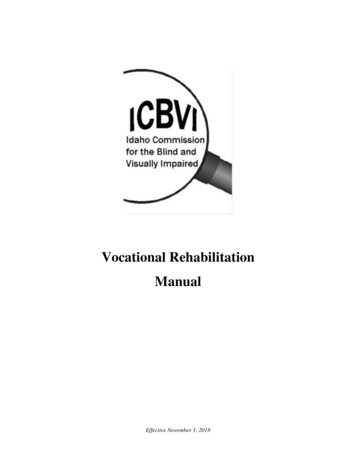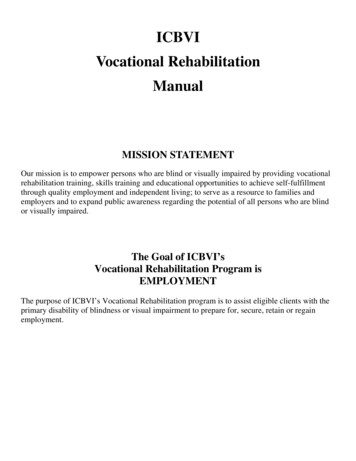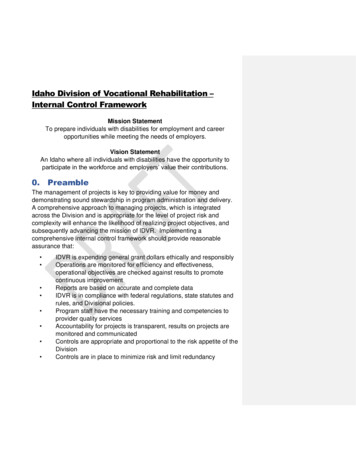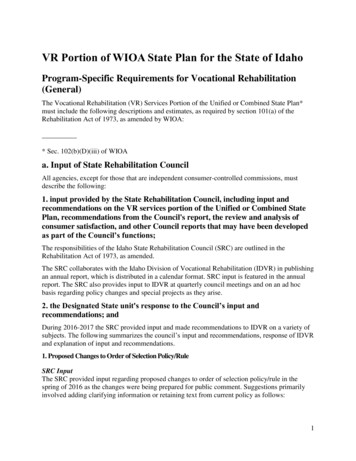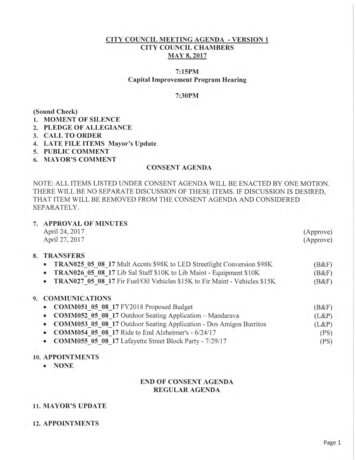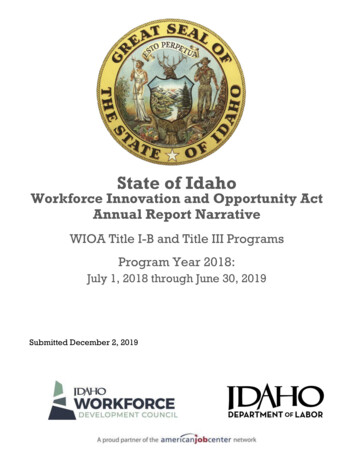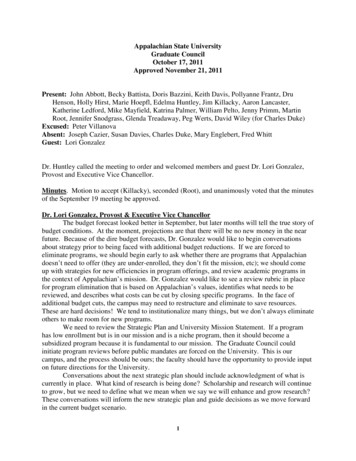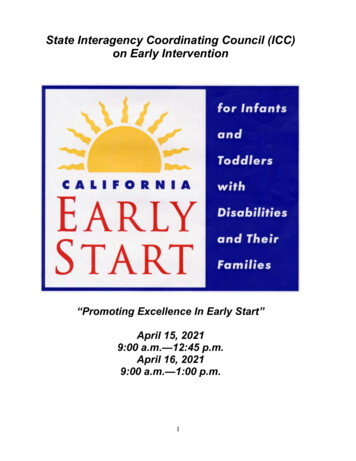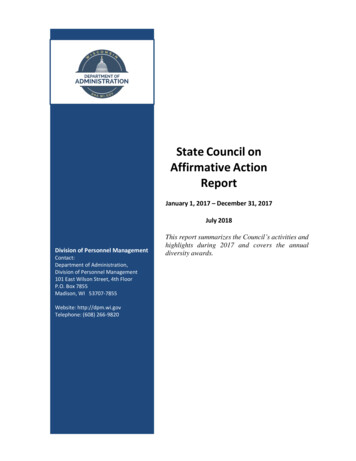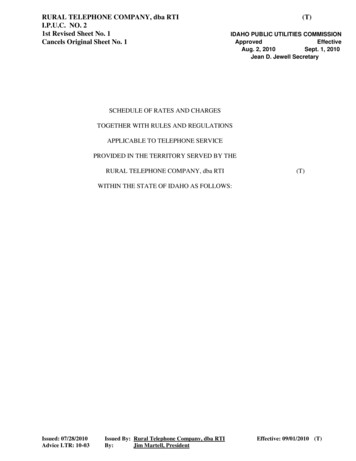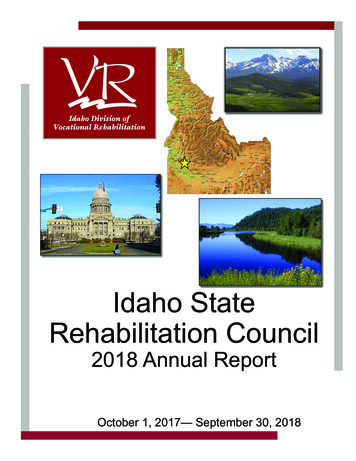
Transcription
Idaho StateRehabilitation Council2018 Annual ReportOctober 1, 2017— September 30, 2018
MISSION of the Idaho State Rehabilitation CouncilTo review, analyze, and advise the Idaho Division of Vocational Rehabilitationregarding services and functions that affect the ability of individuals with disabilities toachieve individual rehabilitation goals.The State Rehabilitation Council(SRC) is composed of volunteersfrom around the state, who showleadership and a commitment toempower Idahoans with disabilities toachieve their goals for employment,independent living, and communityintegration.an advisor and partner to Idaho’sDivision of Vocational Rehabilitation(IDVR) program. Its membersparticipate in IDVR’s strategic planningby guiding and assisting in makingthoughtful, participant-focused decisionsthrough needs assessments, customersatisfaction surveys, and ongoingprogram evaluation.Appointed by the State Board ofEducation, the Council serves both asSTATE REHABILITATION COUNCIL MEMBERSMolly Pollastrini, ChairDisability Advocacy GroupsMel LevitonState Independent Living CouncilJane DonnellanVocational RehabilitationAdministratorSarah TuellerParent Training& Information CenterRamona Medicine HorseAmerican IndianVocational RehabilitationDwight JohnsonWorkforce Development CouncilKendrick LesterState Department of EducationDina Flores-Brewer, Vice ChairClient Assistance ProgramKenna BucknerCommunity Rehabilitation ProgramSuzette WhitingVocational RehabilitationCounselorMike Hauser & Janice CarsonDisability Advocacy GroupsRon Oberleitner, Darin Lindig,Lucas Rose and Rob AtkinsBusiness/Labor/IndustryJoe AndersonFormer Applicant or Recipient2
MESSAGE FROM THE CHAIRAs an advocate for individuals with disabilities and theChair of the Idaho State Rehabilitation Council (SRC) Iwant to thank members of the Council, the wonderfulstaff at the Idaho Division of Vocational Rehabilitation(IDVR), and the Executive Director of the Idaho StateBoard of Education (SBOE) for the continued supportof Idahoans with disabilities. The SRC has a legalresponsibility outlined in federal legislation and isappointed by the SBOE.I am proud to work with such kind and dedicated professionals. The work we do insupport of people with disabilities and businesses is invaluable. The SRCpartnership with IDVR can ensure all eligible Idahoans with disabilities have theopportunity to work and contribute to the state’s economy and tax base. Idahobusinesses profit through access to a trained and eager workforce. And as jobseekers obtain employment, they become more independent and rely less on publicassistance and other support programs. All of which helps stabilize the economicwell-being of the state.As I look back on the accomplishments of this past year I am proud to report anincreased level of cooperation and collaboration with IDVR, greater outreach topeople in all parts of Idaho, and a national presence in promoting best practices inrehabilitation.I have been truly honored to serve Idahoans with disabilities and look forward toexpanding opportunities to all people with disabilities.Sincerely,Molly Pollastrini3
MESSAGE FROM THE ADMINISTRATOROne of my primary roles as the Administrator of IDVR is to be aleader in assuring our mission and vision are achieved. Earlythis year our mission and vision were updated to reflect the dualcustomer focus of the Workforce Innovation and Opportunity Act(WIOA) and to align with our National Vision 2020 initiative. I amexcited about our new mission: “To prepare individuals withdisabilities for employment and career opportunities whilemeeting the needs of the employers”. And our vision: “An Idahowhere all individuals with disabilities have the opportunity toparticipate in the workforce and employers value theircontributions”. The National Vision 2020 initiative also reflects the strongcommitment of the Vocational Rehabilitation (VR) program to both individuals withdisabilities and businesses. Vocational Rehabilitation is the leader in working withindividuals with disabilities; preparing them through career readiness for competitiveintegrated employment. We impact the workforce by helping prepare individuals withdisabilities for careers which assists businesses meet their talent needs. We engagein collaborative strategies with our community partners to best meet the needs ofboth the individual with a disability and the businesses in our communities.Our program changes lives. I am proud of the committed staff of VR and theirdedication to deliver high quality individualized services to individuals with disabilitiesand connect them to businesses who will benefit from their skills and talents.We are continuing to transition and build capacity as required under WIOA. I seeindividual staff and teams working every day to improve our processes, to find uniqueapproaches, and to adapt to requirements set out before us. We have seen theemergence of leadership teams in the areas of business engagement, transition forstudent with disabilities, case documentation, and quality counseling. We continueto strengthen the collaboration with our community partners to develop a dynamicworkforce in Idaho that meets the needs of both the individual job seeker andemployer.I am honored to be granted the opportunity to be the Administrator of VR and amproud of the team of professionals who are dedicated to providing employmentopportunities for individual with disabilities as well as employers. It is a greatpleasure to present this annual report. I want to thank the SRC, the State Board ofEducation, our valued partners, all of the IDVR staff, and most importantly all theindividuals who participated in our program.Sincerely,Jane Donnellan, MA, CRC4
State Rehabilitation CouncilAccomplishments FFY 2018The State Rehabilitation Council and the Idaho Division of VocationalRehabilitation’s shoulder-to-shoulder and face-to-face partnership continued thisyear with a unified vision of enhancing services through the Workforce Innovationand Opportunity Act (WIOA).Council members were actively involved in pre-employment transition servicesdevelopment through high school education summer programs and the Tools forLife Secondary Transition Conference.In addition, the SRC weighed in regarding the use of the Comprehensive StateNeeds Assessment (CSNA) to develop the State Plan and Strategic Plan goals.Further, we provided thoughtful suggestions for the revision of the vision/missionstatement and fine-tuning the Customer Satisfaction Survey.Finally, in preparation for the mid-cycle update of the IDVR Services Portion of theCombined State Plan, the Council developed a list of the input provided by theSRC to the agency over the past two years. VR staff categorized the input by type:changes to policy/rule, qualified hearing officers, Comprehensive Statewide NeedsAssessment, etc.Indeed, our year in review indicates much has been accomplished and we lookforward, with great anticipation, to our upcoming collaborative opportunities.Janice CarsonChair for VR Portion of Combined State Plan and Finance Committee5
VR SUCCESS STORY— NICK HEUSSER JOURNEY TO JOBSNick has a job that he loves and an employer that appreciates his work skills andpositive attitude. But the journey to Nick’s job had some physical challenges. Nickdid not let that stop him from pursuing his dream of getting and keeping a job. Nicklives in Preston, Idaho where jobs are a little harder to come by. A smallercommunity has less employers, so less job opportunities. Nick comes from a familyof people that work hard for a living and he wanted that for himself as well. Nickwanted to contribute to society and gain his independence.He started working with a vocational rehabilitation (VR) counselor in high school.His counselor and him developed a plan in which he went on to pursue and obtain aBachelor of Arts degree. But a job still alluded him.6
VR SUCCESS STORY— NICK HEUSSERJOURNEY TO JOBSAfter working with his VR counselor and doing some research he got a medical codercertification and was hired by Franklin County Medical Center. Adrienne Alvey is hissupervisor and she says besides medical coding, Nick scans documents, getsreleases of information, and “anything I ask him to do.” His job requiresunderstanding human anatomy,accuracy, attention to detail and theability to learn and remember all themedical codes necessary thatcontribute to precise and correctreporting and billing. Nick has takenon this challenge and is eager to domore. When Alvey is asked what isNick’s best quality as an employeeshe says, “his work ethic andappreciation for the job. Both ofwhich are hard things to come by.”Nick says his has life has improvedfor the better since working atFranklin County Medical Center.He doesn’t have to rely on family orfriends and that gives him a senseof self-worth and pride. “I earn mykeep,” says Nick. That is why Nickis a VR Success Story!7
The primary goal of Vocational Rehabilitation (VR) is employment. VRprovides individualized vocational counseling and guidance as well asother services to assist Idahoans with disabilities to make informedchoices concerning their careers in order to become successfullyemployed.Disabilities of the 1,281 Individuals Who Went to WorkOccupations of the 1,281 Individuals Who Went to Work8
By The Numbers—FFY 2018Average Customer Weekly EarningsAverage weekly earnings of customers beforeand after rehabilitation.Before 84.89After 386.58This represents an increase of 355%.Return on InvestmentIn FFY 2018, VR had 1,281 customers whoachieved successful vocational outcomes. Theiraverage weekly earnings equate to an estimated 7,406,501 in state sales taxes paid over theirremaining work life.9
Ticket To Work and Cost ReimbursementTicket to Work is a work incentive thatallows some individuals on Social Securitythe ability to access employment servicesfrom a list of pre-approved providers andgives them protection from Social SecurityAdministration (SSA) medical reviews whilethey are actively working on and makingprogress toward their goals.1,360 Tickets In-Use with IDVR66,905 Eligible Tickets In IdahoMore information can befound from MAXIMUS here:https://choosework.ssa.gov/Cost Reimbursement(CR) is a programwhere SSA rewardsVR agencies forputting individuals backto work and reducingor eliminating their useof SSA income. IDVRrecovered over 1.1Million in CR in 2018.10
Business Engagement2018 Year in ReviewIDVR made great strides forward in business engagement (BE).We now have a business engagement team comprised of staff representatives fromall eight regions in our state as well as two representatives from our regionalmanagers. The goal is to develop and implement a business engagement andoutreach plan from the inside out.Loni Hanka, Business Liaison, leads this newly formed team.We have established our mission:To intentionally create and maintain long-term partnerships with businesses formutually beneficial outcomes for all parties.Six-month goals include: Specific definition of BE activities and talking points/script Clarify/specify expectations for staff including tracking and coordination Develop training for managers and field staffThe year ahead promises to befull of business engagementprogress and developing longterm employer relationships andcollaboration with our partners.11
Services To Students and YouthWith DisabilitiesVR has continued to provide valuable Pre-Employment Transition Services tostudents with a disability around the state. The following opportunities have beenhighlighted:PAID SUMMER WORK EXPERIENCE329 students participated in a week of job skillstraining, followed by five weeks of paid work withbusinesses in 15 different local areas around thestate; additional on the job work training was providedto students, if needed. In addition, 26 students whoare deaf or hard of hearing from around the stateparticipated in job skills training followed by fourweeks of paid work experience; all interpretingservices were included.Several students were hired by the employer eitherduring or after the program ended. Students wereexcited about earning a pay check, but moreimportantly students gained significant confidence intheir abilities during the experience.VANDAL SUMMER ACADEMY (VSA)Student who participated in VSA learned basic collegeskills through participation in course presentations,career development activities, independent living skills,as well as developing next steps for students on theirpath to postsecondary education.12
SELKIRK OUTDOOR LEADERSHIP and EDUCATION PROGRAM(SOLE)For the past two years SOLE has partnered with the Lake Pend Oreille SchoolDistrict and Vocational Rehabilitation to encourage students to take leadership rolesand provide a safe space to push through personal challenges. This STEM focusedprogram teaches students leadership skills while also highlighting employmentopportunities specifically in forestry and conservation.WORK OF ARTThe Idaho Division of Vocational Rehabilitation worked with Idaho Parents Unlimited toprovide students with the opportunity to participate in paid short-term internships workingwith business partners to create corporate works of art under the guidance of a teachingartist. In one opportunity, students worked with HP to develop artwork with the statementof ‘Reinvent’using oldcomputer partsfrom HP.13
Notes/Contacts14
The State Rehabilitation Council and the Idaho Division of Vocational Rehabilitation’s shoulder-to-shoulder and face-to-face partnership continued this year with a unified vision of enhancing services through the Workforce Innovation and Opportunity Act (WIOA). Council members wer
